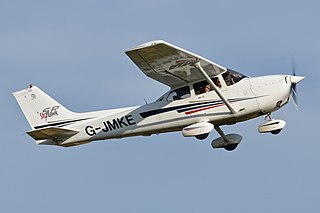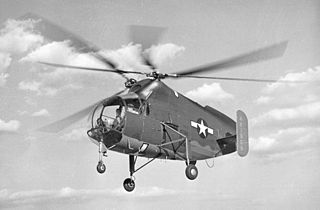
An aircraft is a vehicle that is able to fly by gaining support from the air. It counters the force of gravity by using either static lift or the dynamic lift of an airfoil, or, in a few cases, direct downward thrust from its engines. Common examples of aircraft include airplanes, helicopters, airships, gliders, paramotors, and hot air balloons.

Juan de la Cierva y Codorníu, 1st Count of la Cierva, was a Spanish civil engineer, pilot and a self-taught aeronautical engineer. His most famous accomplishment was the invention in 1920 of a rotorcraft called Autogiro, a single-rotor type of aircraft that came to be called autogyro in the English language. In 1923, after four years of experimentation, De la Cierva developed the articulated rotor, which resulted in the world's first successful flight of a stable rotary-wing aircraft, with his C.4 prototype.
The CarterCopter is an experimental compound autogyro developed by Carter Aviation Technologies in the United States to demonstrate slowed rotor technology. On 17 June 2005, the CarterCopter became the first rotorcraft to achieve mu-1 (μ=1), an equal ratio of airspeed to rotor tip speed, but crashed on the next flight and has been inoperable since. It is being replaced by the Carter Personal Air Vehicle.

The vortex ring state (VRS) is a dangerous aerodynamic condition that may arise in helicopter flight, when a vortex ring system engulfs the rotor, causing severe loss of lift. Often the term settling with power is used as a synonym, e.g., in Australia, the UK, and the US, but not in Canada, which uses the latter term for a different phenomenon.

A tandem-rotor aircraft is an aircraft with two large helicopter rotor assemblies mounted one in front of the other in the horizontal plane. This configuration is mainly used for large cargo helicopters. Such aircraft are often informally referred to as "Chinooks," after the CH-47 Chinook, one of the first widely adopted heavy-lift helicopters with a tandem-rotor configuration.

The Focke-Wulf Triebflügel, or Triebflügeljäger, literally meaning "thrust-wing hunter", was a German concept for an aircraft designed in 1944, during the final phase of World War II, as a defence against the ever-increasing Allied bombing raids on central Germany. It was a vertical take-off and landing tailsitter interceptor design for local defense of important factories or areas which had small or no airfields.

The Boeing X-50A Dragonfly, formerly known as the Canard Rotor/Wing Demonstrator, was a VTOL rotor wing experimental unmanned aerial vehicle that was developed by Boeing and DARPA to demonstrate the principle that a helicopter's rotor could be stopped in flight and act as a fixed wing, enabling it to transition between fixed-wing and rotary-wing flight.

On a helicopter, the main rotor or rotor system is the combination of several rotary wings with a control system, that generates the aerodynamic lift force that supports the weight of the helicopter, and the thrust that counteracts aerodynamic drag in forward flight. Each main rotor is mounted on a vertical mast over the top of the helicopter, as opposed to a helicopter tail rotor, which connects through a combination of drive shaft(s) and gearboxes along the tail boom. The blade pitch is typically controlled by the pilot using the helicopter flight controls. Helicopters are one example of rotary-wing aircraft (rotorcraft). The name is derived from the Greek words helix, helik-, meaning spiral; and pteron meaning wing.

The Bristol Type 192 Belvedere is a British twin-engine, tandem rotor military helicopter built by the Bristol Aeroplane Company. It was designed by Raoul Hafner for a variety of transport roles including troop transport, supply dropping and casualty evacuation. It was operated by the Royal Air Force (RAF) from 1961 to 1969. The Belvedere was Britain's only tandem rotor helicopter to enter production, and one of the few not built by Piasecki or Boeing.

A rotary-wing aircraft, rotorwing aircraft or rotorcraft is a heavier-than-air aircraft with rotary wings that spin around a vertical mast to generate lift. The assembly of several rotor blades mounted on a single mast is referred to as a rotor. The International Civil Aviation Organization (ICAO) defines a rotorcraft as "supported in flight by the reactions of the air on one or more rotors".

The Bristol Type 173 was a British twin-engine, tandem rotor transport helicopter built by the Bristol Aeroplane Company. It was designed by Raoul Hafner as a civil transport helicopter but evoked interest from the military. It did not enter production but was developed into the Bristol Belvedere which was operated by the Royal Air Force from 1961 to 1969.

In aeronautics, an aircraft propeller, also called an airscrew, converts rotary motion from an engine or other power source into a swirling slipstream which pushes the propeller forwards or backwards. It comprises a rotating power-driven hub, to which are attached several radial airfoil-section blades such that the whole assembly rotates about a longitudinal axis. The blade pitch may be fixed, manually variable to a few set positions, or of the automatically variable "constant-speed" type.

A helicopter is a type of rotorcraft in which lift and thrust are supplied by horizontally spinning rotors. This allows the helicopter to take off and land vertically, to hover, and to fly forward, backward and laterally. These attributes allow helicopters to be used in congested or isolated areas where fixed-wing aircraft and many forms of short take-off and landing (STOL) or short take-off and vertical landing (STOVL) aircraft cannot perform without a runway.

The Cierva W.11 Air Horse was a helicopter developed by the Cierva Autogiro Company in the United Kingdom during the mid-1940s. The largest helicopter in the world at the time of its debut, the Air Horse was unusual for using three rotors mounted on outriggers, and driven by a single engine mounted inside the fuselage.

The cyclogyro, or cyclocopter, is an aircraft configuration that uses a horizontal-axis cyclorotor as a rotor wing to provide lift and, sometimes, also propulsion and control. In principle, the cyclogyro is capable of vertical take off and landing and hovering performance, like a helicopter, while potentially benefiting from some of the advantages of a fixed-wing aircraft.

The McDonnell XV-1 is an experimental Convertiplane developed by McDonnell Aircraft for a joint research program between the United States Air Force and the United States Army to explore technologies to develop an aircraft that could take off and land like a helicopter but fly at faster airspeeds, similar to a conventional airplane. The XV-1 would reach a speed of 200 mph, faster than any previous rotorcraft, but the program was terminated due to the tip-jet noise and complexity of the technology which gave only a modest gain in performance.

Raoul Hafner, (1905–1980) FEng, FRAes, was an Austrian-born British helicopter pioneer and engineer. He made a distinctive contribution to the British aerospace industry, particularly in the development of helicopters.
Nicolas Florine, born Nikolay Anatolyevich Florin was a Russian born engineer who settled in Belgium. He built the first tandem rotor helicopter in 1927 - a flying scale model and full size helicopter was built in 1933.

The Kellett XR-8 was a helicopter built in the United States during World War II. It was a two-seat machine intended to demonstrate the feasibility of a twin-rotor system and, while it accomplished this, it also demonstrated a number of problems that prevented further development of this particular design.

The Brennan Helicopter was a British rotary wing aircraft, developed by the Irish engineer and inventor Louis Brennan between the late 1910s and the mid-1920s. The helicopter was powered by a central engine through shafts to propellers mounted on two of the rotor blades.


















